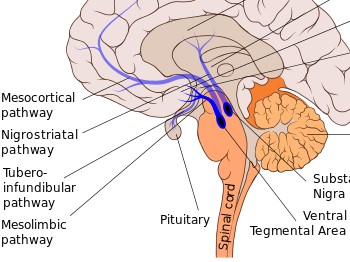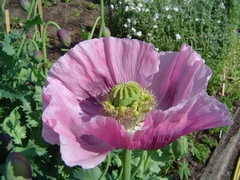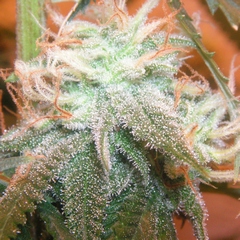|
The Humor
Personality Spectrum Tapestry Select the section that interests you. |
|
|
The Humor
Personality Spectrum Tapestry Select the section that interests you. |
|
This section will have additional content posted to it in subsequent revisions of this chapter (The Humor Personality Spectrum Tapestry). The current version as of this writing is v #1.0.
For those wanting another source for review on various thoughts regarding humor and the possible synergistic reasons that we might benefit from it ... click here → [Humor, laughter, learning, and health! A brief review]
Recall that the mesolimbic dopamine pathway is part of the Reward System.
The mesolimbic pathway - the blue projections from
the VTA to the nucleus accumbens.
The neurological reward system is responsible for incentive salience (i.e., motivation and "wanting", desire, craving), associative learning (primarily positive reinforcement and classical conditioning), and positive emotions, particularly pleasure (e.g., joy, euphoria and ecstasy).
We have also seen that neurological pathways impacted by dopamine and certain dopamine receptors also influence certain behaviors associated with Curiosity, such as novelty seeking. As a reminder ... click here → [Role of neurological aspects and structures on Curiosity]
Dopamine is linked to the process of curiosity. It is responsible for assigning and retaining reward values of information gained. Research suggests higher amounts of dopamine are released when the reward is unknown and the stimulus is unfamiliar. (i.e. Humor.)
In addition, it is commonly observed that Curiosity is highest at very young ages and tends (on average) to decline with age. Similarly, various of the libidos are known to be highest near the ages when sexual maturity is reached and also seem to decline with age. And, we all have experienced the extraordinary joy, laughter, and "fun for fun's sake seeking" of young children.
It is credible, at this point, to imagine that perhaps the Humor, Curiosity, and Libido Tapestries share common components (some of which may decline with age). Or, perhaps one or the other is an actual ensemble component of the other. Thus, if any of the component ensembles decline with age, the overall behavior manifested by the Tapestry would change as well.
Given the observed importance of various of the dopamine influenced neural systems to various behavioral manifestations of humor, fun, reward, ecstasy, emotion, etc., it would be relevant to mention a few of those systems here:
Potentially relevant genes and gene systems:

Papaver somniferum flower- OPRM1 (opioid receptor mu 1) - The μ-opioid receptors (MOR) are a class of opioid receptors with a high affinity for enkephalins (involved in nociception) and beta-endorphin (associated with hunger, thrill, pain, maternal care, sexual behavior, and reward cognition. In the broadest sense, β-endorphin is primarily utilized in the body to reduce stress and maintain homeostasis). They are also referred to as μ-opioid peptide (MOP) receptors. The prototypical μ-opioid receptor agonist is morphine, the primary psychoactive alkaloid in opium. It is an inhibitory G-protein coupled receptor that activates the Gi alpha subunit, inhibiting adenylate cyclase (an enzyme with key regulatory roles in essentially all cells) activity, lowering cAMP levels.
The μ-binding sites are discretely distributed in the human brain, with high densities in the posterior amygdala, hypothalamus, thalamus, nucleus caudatus, putamen, and certain cortical areas.
The euphoria, comprehensive alleviation of distress and therefore all aspects of suffering, promotion of sociability and empathy, "body high", and anxiolysis provided by narcotic opioids can cause the use of high doses in the absence of pain for a protracted period. Morphine is the prototype of the entire opioid class of drugs.
Morphine is an endogenous opioid in humans that can be synthesized by and released from various human cells, including white blood cells.
Animal and human studies and clinical experience back up the contention that morphine is one of the most euphoric drugs known.

Cannabis flower with visible trichomes- 5-HTTLPR (serotonin-transporter-linked polymorphic region) in SLC6A4, the gene that codes for the serotonin transporter.
- The Endocannabinoid System. Two primary endocannabinoid receptors have been identified: CB1 and CB2. CB1 receptors are found predominantly in the brain and nervous system, and are the main molecular target of the endocannabinoid ligand (binding molecule), Anandamide, as well as its mimetic phytocannabinoid, THC. Anandamide plays a role in the regulation of feeding behavior, and the neural generation of motivation and pleasure.
- Dopamine receptor D4 (DRD4) carries the building instructions for a receptor in the brain, which forms the docking station for the neurotransmitter dopamine. Birds with a specific variant of this dopamine receptor D4 gene show a stronger exploratory behavior than individuals with other variants
It is linked to many neurological and psychiatric conditions including schizophrenia and bipolar disorder, ADHD, addictive behaviors, Parkinson's disease, and eating disorders such as anorexia nervosa.
Mutations in this gene have been associated with various behavioral phenotypes, including autonomic nervous system dysfunction, attention deficit/hyperactivity disorder, schizophrenia, and the personality trait of → novelty seeking. ←
In addition to potential heredity, novelty seeking (NS) behaviors are seen with the modulation of dopamine. The overall effect of dopamine when exposed to a novel stimuli is a mass release of the neurotransmitter in reward systems of the brain including the mesolimbic pathway. The mesolimbic pathway is active in every type of addiction and is involved with reinforcement. Because of this activation in the brain, NS has been linked to personality disorders as well as substance abuse and other addictive behaviors. DRD4 receptors are highly expressed in areas of the limbic system associated with emotion and cognition.
Novelty-seeking behavior is probably mediated by several genes, and the variance attributable to DRD4 by itself is not particularly large.
Considering The Humor Tapestry, ConserveLiberty hypothesizes that it may be influenced by several Ensembles of functions. For example:Each of these "Humor Ensembles", which altogether make up the Humor Tapestry, are themselves tapestries and ensembles of Filters or other Ensembles.
- The Curiosity Personality Spectrum Tapestry
- The Libido Personality Spectrum Tapestry
- The Critical Thinking Personality Spectrum Ensemble - enables additional positive adaptation to the current environment. In other words - improvement.
- The Reality Perception Ensemble
- The Bullshit Detection Filter
- The Pattern Recognition Personality Filter
- The Analytical Personality Filter (includes the requirement for verification)
- The Recall Function (recovers memory_a from memory_b for cognition usage.)
- The Memory Function.
- The Difference Engine. The cognitive human brain is built from the ground up to take note of "what is different", and thus can pick out "what is different from what was expected" so long as our indoctrinations allow us to "perceive" them.
- The Environment. All of "What We Are" is influenced to some degree by the environments we find ourselves needing to survive within.
Multiple things fall out of the fact that Environment plays a significant roll with the Humor Tapestry:
- It will be more difficult to uncover many of the biological components that create the Humor Tapestry. There are hundreds, at least.
- In the individual cases where environment plays the predominant role it may also be the case that changes in the environment, or changes in the way one decides to respond to his or her environment may be all that is necessary to impact one's Humor Tapestry status in ways that are both productive and comfortable to live and engage with.
- In other individual cases where environment plays an insignificant role in determining how one experiences and expresses Humor, attempts to alter (or, rehabilitate) one's Humor Tapestry status may be unproductive, moot.
 Consider thoughtfully.
Consider thoughtfully.